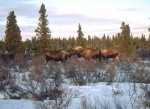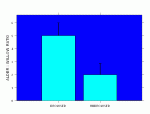Bonanza Creek LTER
by Knut Kielland, BNZ LTER
Additional investigators: John Bryant (PI), Roger Ruess (PI), Graduate students: Loni Rossow, Lem Butler, and Robert McAvinchey
Studies of mammalian herbivory, emphasizing moose and snowshoe hares have been part of the taiga LTER project since 1987. The construction of permanent mammal exclosures on the Tanana River floodplain have allowed us to examine how herbivory modulates microclimate, soil processes, vegetation dynamics, and higher-order interactions in primary succession.
Winter browsing by moose entails the turnover of up to 50% of the annual twig production of preferred forage such as willows, and a delay in green-up by approximately 8-10 days. Belowground, the effects of herbivory are reflected in a 30% reduction in fine root production and a significantly lower rate of mycorrhizal infection. Moose browsing opens up the canopy resulting in warmer and drier soils, which in turn have significant effects on additional soil characteristics including; increased pH, increased nutrient concentrations and element cycling, changes in organic matter composition and soil stable isotope chemistry. These edaphic changes are augmented by herbivore-mediated changes in vegetation succession from a dominance of willows to dominance of N-fixing alder. These modifications in the physico-chemical environment and vegetation are further manifested in the community composition at large. For example, the abundance and composition of the insect guilds living on the forest floor exhibit marked differences in the presence versus absence of herbivory. Thus, our three-dimensional exclosures have revealed m-dimensional interactions. After a decade of work, we are starting to obtain a few glimpses into these ecological cascades stemming from mammalian herbivory in taiga forests.
Relevant literature
Kielland, K. 2001. Stable isotope signatures of moose in relation to seasonal forage composition: a hypothesis. Alces 37:1-9.
Kielland, K. and J.P. Bryant. 1998. Moose herbivory in taiga: effects on biogeochemistry and vegetation dynamics in primary succession. Oikos 82:377-383.
Kielland, K. and Osborne, T. 1998. Moose browsing on feltleaf willow: optimal foraging in relation to plant morphology and chemistry. Alces 34:149-155.
Ruess, R.W., R.L.,Hendrick, and J.P. Bryant. 1998. Regulation of fine root dynamics by mammalian browsers in early successional Alaskan taiga forests. Ecology 79:2706-2720.
Kielland, K., J.P. Bryant, and R. Ruess. 1997. Mammalian herbivory and carbon turnover in early successional stands in interior Alaska. Oikos 80:25-30.
Rossow, L.J., J.P. Bryant, and K. Kielland. 1997. Effects of above-ground browsing by mammals on mycorrhizal colonization in an early successional taiga ecosystem. Oecologia 110:94-98.

 Enlarge this image
Enlarge this image


